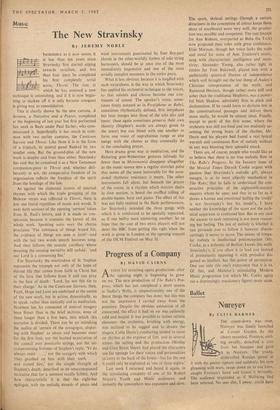The New Stravinsky
By JEREMY NOBLE This is clearly shown by the new cantata, A Sermon, a Narrative and a Prayer, completed at the beginning of last year but first performed last week in Basle under Paul Sacher, who com- missioned it. Superficially it has much in com- mon with two earlier cantatas, the Canticum Sacrum and Threni. Like them it is in the form of a triptych, its central panel flanked by two smaller ones. But the ground-plan of the new work is simpler and freer than either. Stravinsky has said that he conceived it as a New Testament companion-piece to Threni and, whether deli- berately or not, the comparative freedom of its organisation reflects the freedom of the spirit from the bondage of the law.
As against the elaborate system of internal rhymes with which the triple grouping of the Hebrew verses was reflected in Threni, there is just one literal repetition of music and words. It ends both sections of the opening 'sermon' taken from St. Paul's letters, and it is made so con- spicuous because it contains the kernel of the whole work. Speaking sotto voce the chorus proclaims 'The substance of things hoped for, the evidence of things not seen is faith'—and with the last two words speech becomes song. And then follows the ecstatic corollary whose meaning the ensuing narrative will unfold: 'and our Lord is a consuming fire.'
For Stravinsky the martyrdom 'Of St. Stephen represents the triumph not only of the hope of eternal life that comes from faith in Christ but of the love that follows from it and can pray in the face of death: 'Lord, lay not this sin to their charge.' As in the Canticum Sacrum, then, Faith, Hope and Love are enshrined at the centre of the new work, but in action, dynamically, so to speak, rather than statically and in meditation. Nowhere has ,his command of musical imagery been firmer than in the brief sections, none of them longer than a' few bars, into which this narrative is divided. There can be no mistaking the malice of 'certain of the synagogue, disput- ing with Stephen' as oboes and bassoons enter for the first time, nor the hushed expectation of the council over ponticello strings, nor the un- compromising firmness of Stephen's reply, 'Ye do always resist . . . ,' nor the savagery with which 'they gnashed on him with their teeth . . . and stoned him,' nor the simple strength of Stephen's death, described in an unaccompanied recitative that for a moment recalls Schutz. And how characteristic it is that the eight-bar epilogue, with the melodic strands of piano and
wind instruments punctuated by four five-part chords in the other-worldly timbre of solo string harmonics, should be at once one of the most immediately impressive and one of the most serially complex moments in the entire piece.
What is less obvious, because it is haildled with such naturalness, is the way in which Stravinsky has applied his orchestral technique to the voices, so that soloists and chorus become one con- tinuum of sound. The speaker's voice, some- times freely notated as in Persephone or Babel, sometimes rhythmically defined, first introduces but later merges into those of the solo alto and tenor; these again sometimes preserve their own identity (Stephen's words are always given to the tenor) but can blend with one another to form one voice of suprahuman range or else merge with the chorus as they eventually do in the concluding prayer.
Here drama gives way to meditation, and the flickering post-Webernian gestures (already far fewer than in Movements) disappear altogether as the music moves into a regular crotchet pulse that seems all the more inexorable for the occa- sional rhythmic resistance it meets. The other instruments fall silent, but beneath the prayer of the voices, in a rhythm which mirrors theirs in slow motion, is heard the muffled tolling of double-basses, harp and piano. The effect of this was not fully realised in the Basle performances, for Stravinsky intended the three gongs with which it is reinforced to be spatially separated, as if one belfry were answering another; let us hope that the cost of two extra players will not deter the BBC from getting this right when the work is given in London at the opening concert of the ISCM Festival on May 31.


































 Previous page
Previous page